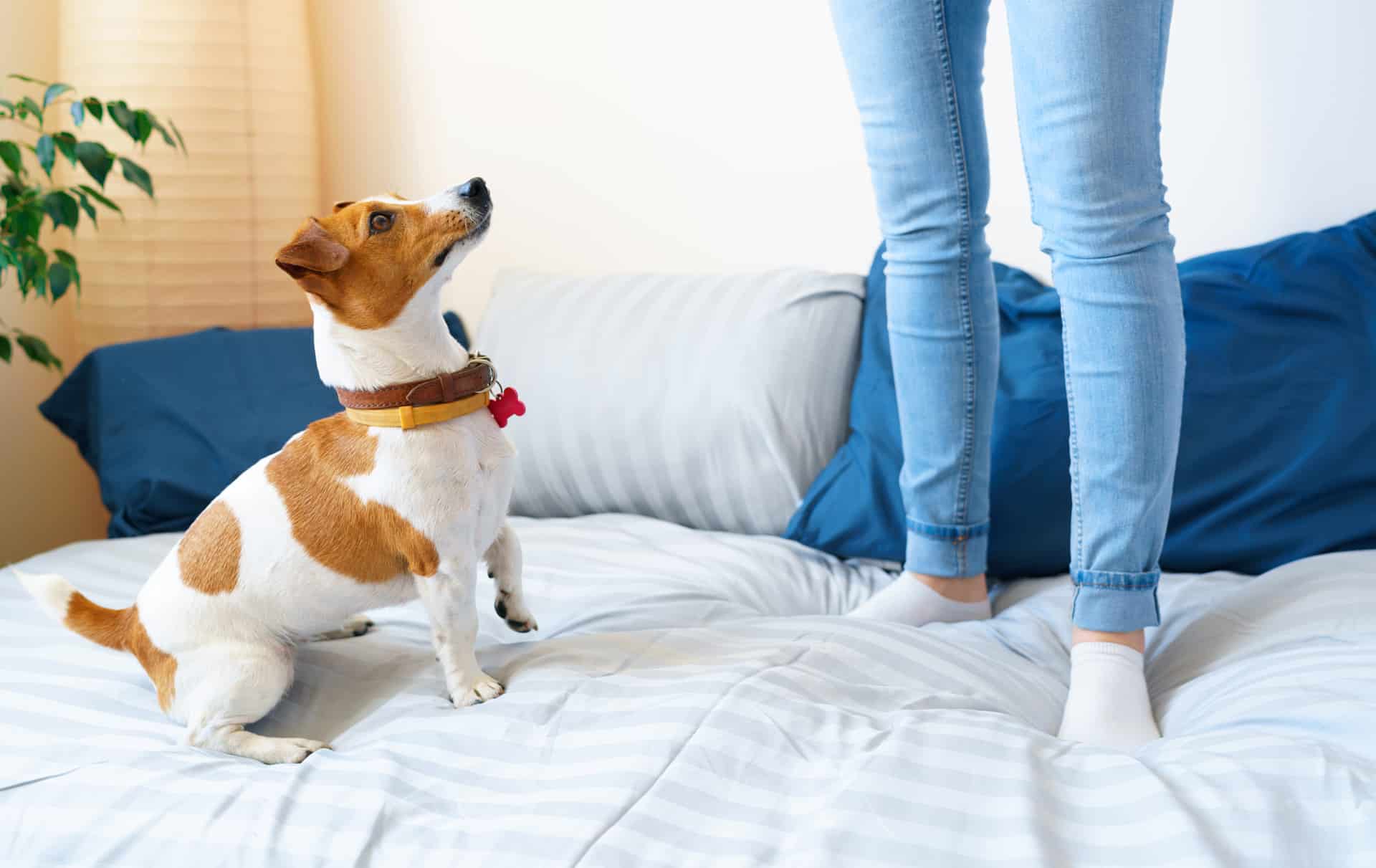The Importance of Consistency in Keeping Dogs Off Furniture
Consistency is essential to keep dogs away from furniture. Establish rules and stick to them to form a habit your dog will follow. Here are some tips:
- Provide a comfy spot like a dog bed for your pup.
- Reward good behaviour with treats or verbal praise.
- Don’t let them on furniture even for a short time, it can cause confusion.
- Set clear limits and let them know they can join you only when invited.
- Always use the same commands and reinforcement.
- Pro tip: Consistency is important in all aspects of training, from potty to obedience. With clear rules and consistency, you and your furry friend can have a great relationship.
Understanding the need for consistency when training a dog
Training a pup? Consistency is key! Set rules, and stick to them. This will help your pup understand what you want. And it’ll make training easier and more successful. Get consistent, and get results!
Benefits of being consistent in training your dog
Consistency is key when it comes to training your doggo. Here’s why:
- Avoid confusion. A consistent training method will help your pup understand desired behavior and avoid getting bewildered.
- Strengthen the bond. Consistent training encourages trust and respect between you and your pup.
- Stop bad habits. Consistent reinforcement of positive behavior stops ’em from jumping on furniture and biting.
To sum it up: Being consistent with training helps stop bad habits, strengthens the bond between you and your pet, and lets them understand expectations.
Pro tip: Reward-based training techniques help even more!
Consequences of not being consistent in training your dog
Inconsistent dog training can have serious consequences. It may result in behavioral issues, which are hard to correct. Therefore, consistency is essential! A lack of it may cause confusion, frustration and even aggression in your pet.
Your pup may become anxious and disobedient if you are inconsistent with training them. Allowing them on furniture one day and not the next sends mixed signals. This confuses and stresses them out.
Consistency helps reinforce good behavior and understanding of the rules. Without it, the pup can’t learn what is expected from them. This could lead to bad behavior in the future.
In conclusion, consistency is key when training your dog. It will keep your relationship happy and healthy. Make sure to set clear rules and boundaries, and stick to them!
How inconsistency affects your training goals
Inconsistency is a huge problem for training dogs. New tricks or bad habits like jumping on furniture? It can mess up all your effort. Here’s why: Dogs like routine and predictability. Rules and expectations changing confuses them. If sometimes you let them sit on the couch, then scold them, they won’t know why they’re being punished. It’s important to be consistent. Training methods, expectations, and reinforcement must be the same. Everyone in the house must be on the same page. The more consistent you are, the more successful you’ll be in reaching your training goals.
Approaches for training dogs to stay off furniture
Training dogs? Consistency is a must. For pooches to understand what’s expected, structure and consistency are essential. Effective yet humane and non-coercive approaches help keep Fido off furniture. Here’s a few ideas:
Positive reinforcement training techniques
Positive reinforcement is a great way to show your pup to stay off furniture. Consistency is the key! Here are some steps to successfully train your furry friend:
- Reward them for using their designated bedding area with treats and positive reinforcement.
- Be strict with the rules and never allow them on furniture – not even once.
- Redirect their attention when they try to climb up.
- Enforce a “no furniture” command with a clear and firm tone.
- Provide plenty of exercise, toys, and attention to keep them busy in their own area.
Training takes time, patience, and consistency – but you can have a well-behaved pup and teach them to stay off the furniture with positive reinforcement!
Using treats and praise to reinforce good behavior
Train your pup to stay off furniture with treats and praise! It’s an effective approach. Here’s how to do it:
- Give your dog a treat and praise with a happy voice when they lie on their bed or sit on the floor.
- Be consistent – don’t let them on the couch one day and not the next. It’ll confuse them.
- Repeat the reward and praise each time they do it right.
Pro Tip: Say “off” or “down” when they try to jump on furniture. It alerts them to the boundaries and keeps them from getting confused.
Redirection and distraction methods
Train your pup to stay off furniture with redirection & distraction methods! Consistency is key – mixed signals might confuse them and slow down the process.
Here are some tips:
- Provide a comfy bed – this makes it less likely for them to seek out couches or beds.
- Positive reinforcement – reward with treats or belly rubs when they stay off.
- Vocal commands – use a consistent command like “off” or “down”.
- Redirect attention – offer toys or treats to distract.
Negative reinforcement training techniques
Negative reinforcement is a dog training technique that stops certain behaviors by adding an unpleasant consequence. An example is teaching your pooch to keep off furniture. Here are some tips:
- Loud noises: Clap, whistle, or make other loud sounds that your pup links with surprise and noise.
- Spray bottle: Keep a spray bottle near and spray your pup if they jump on the furniture. The surprise of the water should stop them.
- Punishing words: Say “No!” firmly and back it up with lesser punishment.
It’s key to be consistent. Reward your dog when they stay off the furniture too. Doing both positive and negative reinforcement will show them what to do.
Use of deterrents to discourage negative behavior
Using deterrents is a humane way to train your pooch to stay off furniture and discourage bad behavior. Here are some ideas to get you started:
- Apply dog deterrent sprays to furniture.
- Cover furniture with aluminum foil to make it uncomfortable.
- Put citrus-scented candles, sprays, or peels around the house/furniture – dogs don’t like the smell of citrus.
- Set up motion-activated devices like alarms or noisemakers to startle the doggo when they jump on the furniture.
- Be consistent when using deterrents. When you catch your pup on the furniture, use a firm tone to say “No” and then give a specific command to move away. Over time, they’ll learn to stay away from the furniture.
- Pro tip: Provide a comfy alternative for them to rest on – like a designated dog bed or cushion near you – this will help them stay off furniture.
Providing consequences for unwanted behavior
Train your pup to stay off furniture with consequences! Verbal cues like “No!” or “Off!“, hand signals, or motion-activated alarms/h2o sprays can be effective.
Be consistent and give consequences each time. Plus, reward good behavior with treats, praise, or a comfy spot!
Avoid punishing/physical force – it’s harmful.
Remember – patience and positive reinforcement are key for successful training!
Importance of using the same approach consistently
Consistency is key when it comes to training your pup to stay off furniture. Dogs love routines and they learn best through repetition. Inconsistency can be confusing and frustrating for both the pup and the owner, making it harder to understand expectations. Establishing clear boundaries with consistency is super important for the pup’s well-being. To reinforce the training process, reward good behavior with treats or verbal affirmations.
Implementing consistent rules and routines
It’s important to keep your dog off furniture for good habits and respect. Consistency is key in training. Being consistent with expectations, and enforcing them, is the best way to make sure your pet understands and respects you. Let’s see how consistent rules and routines help keep your dog off furniture.
Establishing consistent rules for your dog
Creating consistent rules for your pup is essential for a healthy and joyful relationship. Establishing rules and routines will aid your pup in understanding their spot in your home and what behavior is okay.
Here are reasons why staying consistent is essential to keep dogs off the furniture:
- Dogs love structure and routine. When you set up clear rules and remain focused on them, your pooch will comprehend what is expected of them. This will lower their stress and nervousness.
- Inconsistency can perplex your pup and cause unwanted behaviors, like jumping on furniture. If you permit your dog on the sofa one day and then scold them for it the next, they won’t understand why their behavior is not okay.
To keep your pup off the furniture, make a consistent rule that they are not allowed on the couch or bed. Give them comfy spots to take a break, like a dog bed or blanket on the floor. Give them plenty of compliments and treats when they obey the rules, and guide them to their appointed spot when they disobey.
Pro tip – Consistency is important for pup training. Be patient and consistent in following your rules, don’t give up! In time, your pup will comprehend the rules and understand what is required of them.
Maintaining a regular routine for your dog
Having a routine for your pooch is important for their well-being. This also helps keep them away from furniture that you don’t want damaged. Dogs love routine and consistency. Therefore, it’s a must to have a regular schedule for meals, playtime, and exercise. This will help your pup understand your rules and expectations.
If you want to keep your dog off the furniture, you need patience and lots of positive reinforcement. Here are some tips:
- Provide your doggo with a comfortable place to relax.
- Train them to obey the “off” command. Give them treats and praises when they listen.
- Install baby gates or barriers to block access to certain rooms or furniture.
- Be consistent with your training and set clear rules. With time and effort, your pup will learn and become a happy part of the family.
How consistency creates a structure for your dog
Consistency is key for training your pup and rewarding them for good behaviors. This builds structure and encourages routines. Here are several ways to stay consistent:
- Set rules and boundaries from the start, and keep to them.
- Use the same verbal and non-verbal cues to communicate.
- Put a routine in place for feeding, exercising, and training.
- Consistently give rewards for good behavior, and follow through with consequences for bad behavior.
By building a consistent environment for your dog, you create trust and a positive relationship, and make sure they understand what’s expected of them.
Troubleshooting inconsistent behavior in dogs
Consistency is a must when training dogs to stay off furniture. If you don’t stay consistent, your pup will struggle to understand what you expect from them. Therefore, it’s vital to set up a consistent system of commands and rewards. In this section, we’ll talk about how to troubleshoot inconsistent behavior in dogs.
Common reasons for inconsistent behavior
Crazy canine conduct? It can be caused by many things. Like inadequate training, unclear messages, and improper reward systems. Here’s a few of the usual reasons:
- No Training: Teach ’em how to act. Otherwise, they don’t know what’s expected.
- Muddled Messages: If the commands and expectations are unclear, the pup won’t comprehend.
- Inconsistent Reinforcement: Praise one day. Scold the next. This confuses doggos.
For consistent behavior, communicate clearly, train well, and reward consistently!
Correcting inconsistent behavior with consistency
Consistent behavior is a must for effective dog training, especially to keep them off furniture. Inconsistency in rules makes dogs confused and gives mixed messages.
Here are some tips to stay consistent:
- Set clear rules and make sure everyone in the home follows them.
- Every time your dog tries to climb furniture, say ‘off’ and follow through.
- Don’t let your dog sit on furniture sometimes, then not other times.
- Teach your dog that there are positive effects when they behave well, and negative when they don’t.
- Practice consistency daily with positive reinforcement like treats and praises. Tip – Have treats near you to reward good behavior, and talk to your dog in a positive tone to train them.
Seeking professional help when needed
Frustrating inconsistent behavior in dogs can drive owners mad. Dogs often seek furniture and resist learning new habits. The importance of consistency in keeping them off furniture is big. Reasons for this behavior may include stress/anxiety, lack of training/reinforcement, medical issues, or personality traits. Seek help from a vet or trainer to identify the root cause and customize a plan. Remember: be patient & consistent.
Pro tip: Consistency is key, but okay to ask for help if feeling overwhelmed.
Frequently Asked Questions
Q: Why is consistency important in keeping dogs off furniture?
A: Consistency is important because dogs thrive on routine and consistent rules. If you allow them on the furniture occasionally, they will continue to try to get on it all the time, which can lead to behavior problems.
Q: How often should I reinforce the rule of not allowing my dog on the furniture?
A: It’s important to reinforce the rule every time your dog attempts to jump on the furniture, even if that means correcting them multiple times per day.
Q: What are some techniques for keeping my dog off the furniture?
A: Some effective techniques include using positive reinforcement to reward your dog for staying off the furniture, providing them with their own comfortable bed, using physical barriers like baby gates, and using deterrent sprays or mats.
Q: Can I ever allow my dog on the furniture?
A: If you choose to allow your dog on the furniture, it’s important to establish clear boundaries and rules. For example, you might allow your dog on the couch but not on the bed, or only allow them on the furniture if they are invited up.
Q: What are some consequences of not enforcing consistency in this area?
A: If you allow your dog on the furniture inconsistently, it can lead to confusion and frustration for your dog, which can manifest in other behavior problems like barking, chewing, and separation anxiety.







